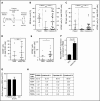inv(16) and NPM1mut AMLs engraft human cytokine knock-in mice
- PMID: 27581357
- PMCID: PMC5084606
- DOI: 10.1182/blood-2015-12-689356
inv(16) and NPM1mut AMLs engraft human cytokine knock-in mice
Abstract
Favorable-risk human acute myeloid leukemia (AML) engrafts poorly in currently used immunodeficient mice, possibly because of insufficient environmental support of these leukemic entities. To address this limitation, we here transplanted primary human AML with isolated nucleophosmin (NPM1) mutation and AML with inv(16) in mice in which human versions of genes encoding cytokines important for myelopoiesis (macrophage colony-stimulating factor [M-CSF], interleukin-3, granulocyte-macrophage colony-stimulating factor, and thrombopoietin) were knocked into their respective mouse loci. NPM1mut AML engrafted with higher efficacy in cytokine knock-in (KI) mice and showed a trend toward higher bone marrow engraftment levels in comparison with NSG mice. inv(16) AML engrafted with high efficacy and was serially transplantable in cytokine KI mice but, in contrast, exhibited virtually no engraftment in NSG mice. Selected use of cytokine KI mice revealed that human M-CSF was required for inv(16) AML engraftment. Subsequent transcriptome profiling in an independent AML patient study cohort demonstrated high expression of M-CSF receptor and enrichment of M-CSF inducible genes in inv(16) AML cases. This study thus provides a first xenotransplantation mouse model for and informs on the disease biology of inv(16) AML.
© 2016 by The American Society of Hematology.
Figures


Comment in
-
MISTRG extends PDX modeling to favorable AMLs.Blood. 2016 Oct 27;128(17):2111-2112. doi: 10.1182/blood-2016-09-738757. Blood. 2016. PMID: 27789435 No abstract available.
References
-
- Döhner H, Estey EH, Amadori S, et al. European LeukemiaNet. Diagnosis and management of acute myeloid leukemia in adults: recommendations from an international expert panel, on behalf of the European LeukemiaNet. Blood. 2010;115(3):453–474. - PubMed
-
- Döhner H, Weisdorf DJ, Bloomfield CD. Acute myeloid leukemia. N Engl J Med. 2015;373(12):1136–1152. - PubMed
-
- Kennedy JA, Mitchell A, Chen WC, et al. Leukemic engraftment in NOD.SCID mice is correlated with clinical parameters and predicts outcome in human AML [abstract]. Blood. 2013;122(21) Abstract 50.
MeSH terms
Substances
Grants and funding
LinkOut - more resources
Full Text Sources
Other Literature Sources
Medical
Molecular Biology Databases
Research Materials

